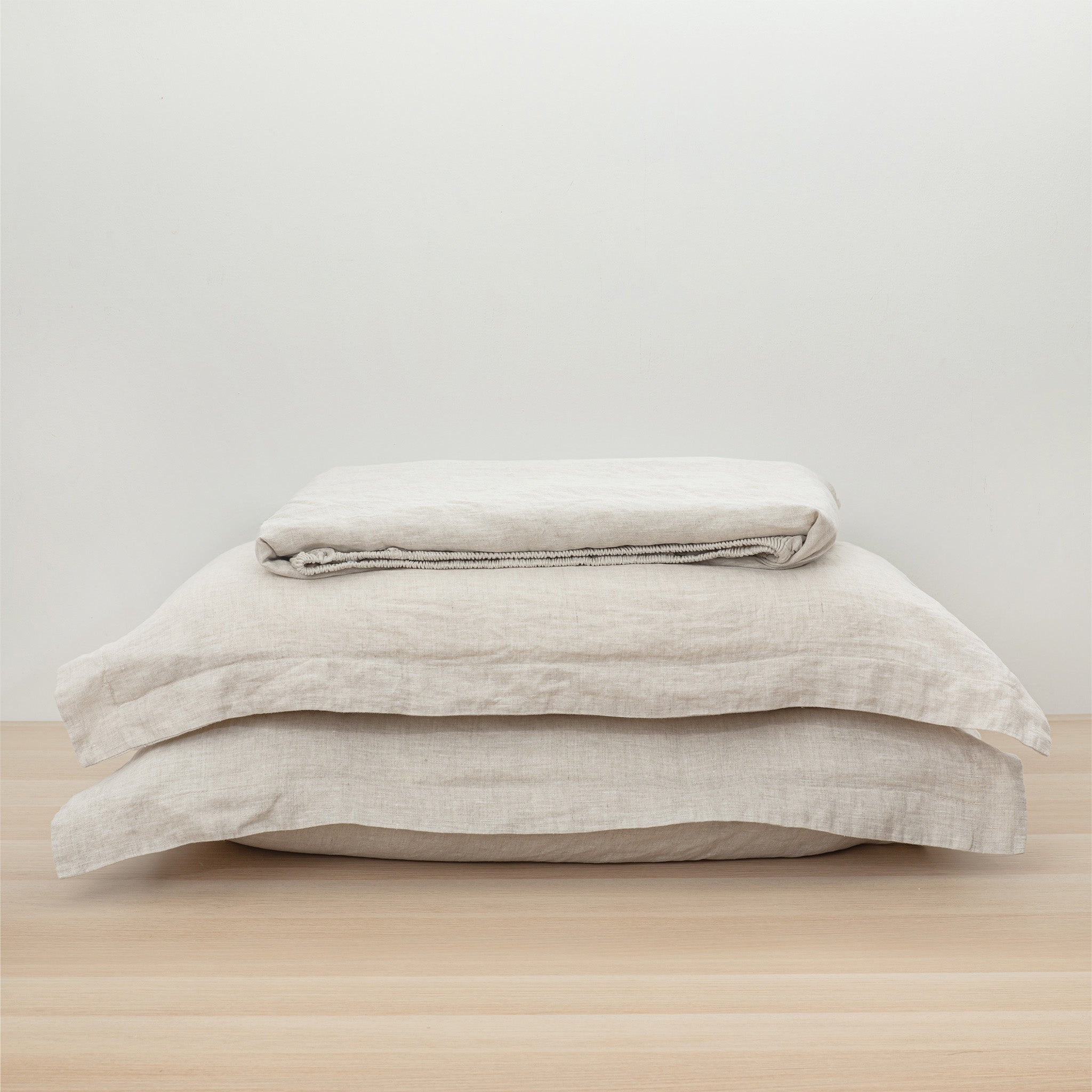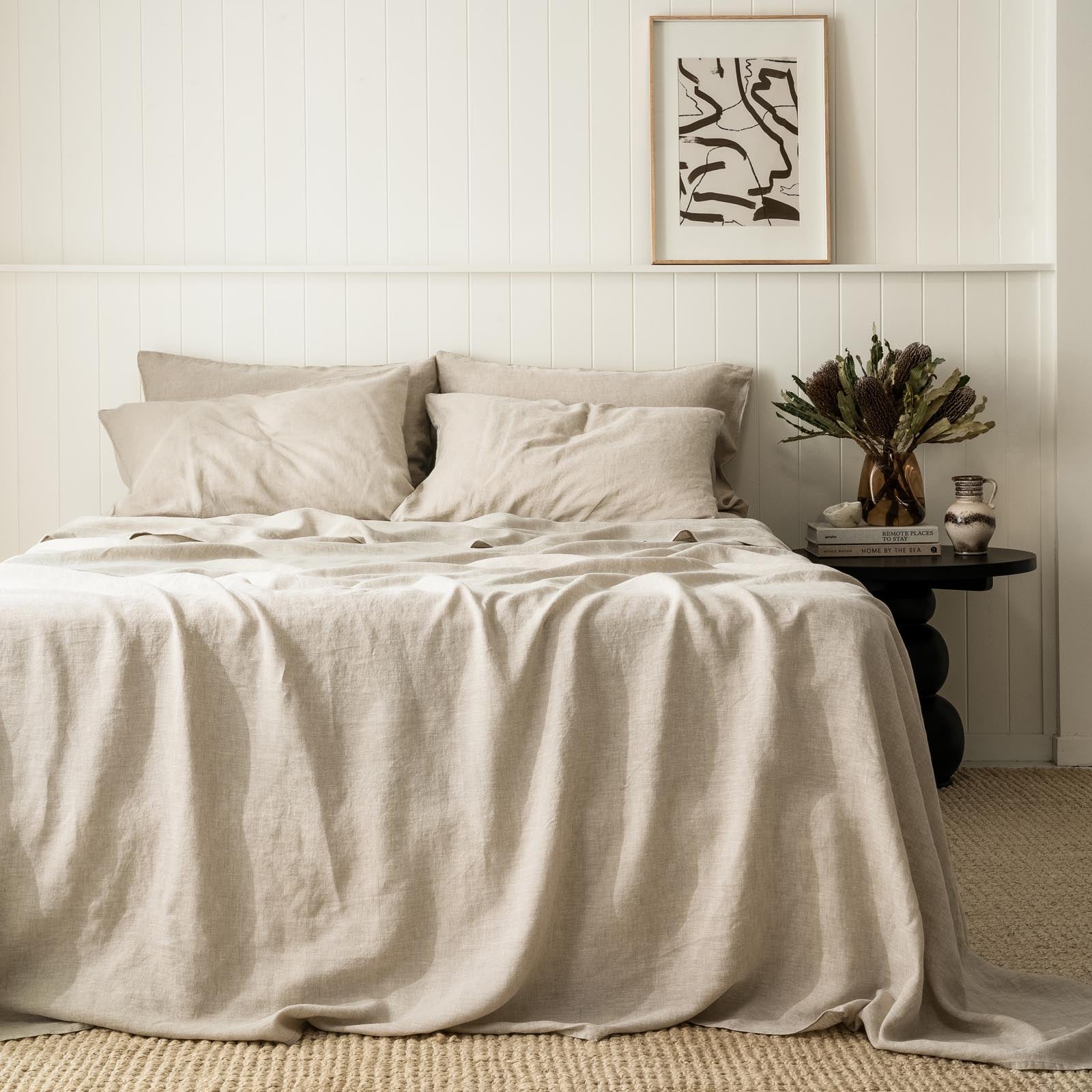Understanding Bed Linen: The Eco-Friendly Choice for Comfy Living
When you think of green fabrics, bed linen frequently stands out for its one-of-a-kind top qualities. This all-natural textile, made from the flax plant, supplies both comfort and sustainability. Its impressive residential or commercial properties make it a suitable choice for warm weather condition and resilient use. What absolutely sets linen apart from other materials? Comprehending its beginnings and benefits can transform just how you watch home fabrics. Allow's explore the interesting world of bed linen additionally.
The Beginnings of Bed Linen: From Flax to Material

Linen, one of the oldest fabrics recognized to humankind, has a fascinating journey that begins with the humble flax plant. As soon as collected, the flax stalks undertake a process called retting, where they're saturated to separate the fibers from the woody parts.
When you see bed linen fabric, you're seeing centuries of workmanship. The weaving procedure transforms those spools of string right into the attractive, durable fabric you love. Linen has been treasured for its all-natural feel and look, making it a preferred for every little thing from clothing to home fabrics. So, next time you touch bed linen, remember its abundant history that links you to ancient cultures and their standard techniques - Australia Linen.
The One-of-a-kind Properties of Bed Linen
Among the standout attributes of this exceptional material is its breathability. When you use bed linen, you'll discover exactly how it permits air to distribute, keeping you cool down on warm days. This home makes it a best choice for summer apparel and sheets.
Linen likewise boasts outstanding moisture-wicking capabilities, drawing sweat far from your skin and enabling it to vaporize swiftly. You will not really feel clammy, even in damp problems. Additionally, bed linen is resilient, typically becoming softer and more comfortable with each clean, which means it can stand the examination of time in your wardrobe.
Another one-of-a-kind aspect is its natural structure; the slight abnormalities give bed linen a character that improves your style. Plus, it withstands creases better than many various other textiles, so you can appreciate a relaxed yet brightened look without much initiative. Welcome bed linen, and you'll appreciate its convenience and distinct charm.
Ecological Advantages of Linen
When you select linen, you're not simply choosing a stunning material; you're additionally supporting sustainable production methods. Linen's biodegradable and compostable nature makes it a wise choice for the environment. And also, it needs considerably less water to produce contrasted to various other fabrics, aiding preserve this precious resource.
Sustainable Production Practices
Although several fabrics have significant ecological effects, bed linen attracts attention as a result of its lasting manufacturing techniques. When you pick bed linen, you're selecting a textile made from the flax plant, which requires very little water and pesticides. This resistant plant can prosper in inadequate dirt problems, minimizing the need for chemical plant foods. Furthermore, the whole flax plant is used in manufacturing, reducing waste and promoting source efficiency.
Bed linen production is frequently much less energy-intensive contrasted to other fabrics, as it includes all-natural procedures as opposed to synthetic treatments. By supporting bed linen, you're adding to a more lasting fabric market that focuses on environmentally friendly methods. Choosing bed linen not only enhances your convenience yet also aligns your values with ecological responsibility.
Eco-friendly and Compostable Material
Bed linen's green nature expands beyond its sustainable manufacturing; it's compostable and also eco-friendly, making it an exceptional choice for eco conscious customers. When you pick linen items, you're going with products that damage down naturally, returning nutrients to the earth. This suggests that at the end of their life cycle, your bed linen items won't contribute to garbage dump waste. Rather, they can break down safely, decreasing your environmental impact. Composting linen can improve soil, promoting healthy plant growth. By including linen into your home, you're not simply appreciating its convenience and longevity; you're likewise aiding and sustaining green techniques create a healthier world. Embrace linen, and really feel excellent about your options for the environment.
Reduced Water Consumption
One of the standout benefits of bed linen is its low water usage throughout growing. Unlike cotton, which calls for considerable watering, bed linen's flax plant flourishes on marginal water, making it a more lasting selection. You'll appreciate understanding that for every ton of bed linen produced, significantly less water is needed contrasted to many other textiles.
Linen vs. Other Fabrics: A Comparison
When you compare linen to various other fabrics, you'll discover its superior breathability and convenience, making it best for cozy climate. And also, linen stands out for its sturdiness and durability, commonly lasting longer than several frequently used products. As you consider your choices, the ecological effect of each material will certainly also play a necessary role in your choice.
Breathability and Comfort
Breathability is an essential consider selecting textiles for convenience, particularly in warm climate. Bed linen attracts attention amongst materials for its exceptional capacity to enable air blood circulation. Unlike artificial materials, which can catch heat and moisture, linen's natural fibers wick away sweat, maintaining you amazing and completely dry. When you use linen, you'll observe just how it really feels light versus your skin, boosting your comfort during warm days.
Cotton is frequently praised for its softness, but it doesn't match bed linen's breathability. If you prioritize convenience, especially in summer, bed linen must be your go-to option.
Resilience and Durability
While numerous textiles use varying levels of resilience, bed linen genuinely stands out in longevity, making it a wise financial investment for your wardrobe. Unlike cotton or artificial materials that might put on out swiftly, linen obtains stronger with each clean. You'll find that linen's breathable nature additionally reduces wear from sweat and dampness, which can harm various other textiles.
Environmental Effect Contrast
Although many fabrics contribute to ecological issues, bed linen sticks out for its environmentally friendly high qualities. Unlike cotton, which needs large water resources and pesticides, linen is made from flax, a plant that grows on very little water and requires fewer chemicals. This indicates you can really feel great about your choice while lowering your carbon footprint.
When contrasted to artificial materials like polyester, bed linen's biodegradability shines. While polyester can take hundreds of years to decay, linen breaks down normally, returning nutrients to the soil.
Selecting linen not only advertises lasting farming methods however additionally sustains a much healthier world. By selecting linen over conventional fabrics, you're making an aware decision that profits both your comfort and the atmosphere.
Taking care of Your Linen Textiles
To guarantee your bed linen fabrics continue to be in wonderful condition, you'll desire to adhere to some straightforward care standards. First, wash your linen in cool water on a gentle cycle to avoid it from shrinking or losing its form. Prevent making use of bleach, as it can damage the fibers. Instead, choose a moderate cleaning agent that's cost-free from severe chemicals.
When it pertains to drying out, air drying out is best. If you make use of a dryer, choose a reduced warm setting and eliminate the items while they're still a little damp to decrease creases. Iron the linen while it's still damp for much easier handling, or vapor it to maintain it looking crisp.
For storage space, keep your bed linen in an awesome, dry location. Stay clear of straight sunshine to prevent fading. With these simple methods, your linen fabrics will keep their elegance and last for several years, making them a lasting enhancement to your lifestyle.
Incorporating Linen Into Your Home Décor
Taking care of your linen textiles not just preserves their high quality but also opens a world of opportunities for integrating them into your home décor. You can Linenshed begin tiny by including linen throw cushions to your sofa, instantaneously raising the space with texture and warmth. Consider bed linen drapes that filter sunshine wonderfully, producing a soft, ventilated environment in any kind of area.
For a more rustic look, try utilizing bed linen tablecloths or joggers throughout meals; they include a stylish touch and are easy to clean. If you're really feeling daring, mix and suit different linen colors and patterns to produce an unique, split result.
Don't forget bed linen blankets-- drape one over a chair or your bed for an inviting feeling. By thoughtfully incorporating linen into your decoration, you improve both convenience and style, making your home a tranquil resort.
The Future of Linen in Sustainable Living
As consumers progressively focus on sustainability, bed linen emerges as a frontrunner in green textiles. Its production makes use of less water and pesticides contrasted to standard cotton, making it an extra environmentally responsible choice. As you look towards a sustainable future, incorporating linen right into your wardrobe and home can greatly lower your carbon impact.
Ingenious brand names are currently focusing on sustainable practices, from utilizing organic flax to executing circular economic situation concepts. You'll locate that linen's toughness suggests it lasts longer, decreasing the demand for regular substitutes.
Furthermore, as even more individuals accept minimalist way of livings, bed linen's classic appeal and adaptability will keep it pertinent. By picking linen, you're not just going with comfort; you're also supporting lasting techniques.
In the upcoming years, the need for linen is anticipated to expand, strengthening its location in a much more eco-conscious world. So, consider making linen a staple in your sustainable living journey.
Frequently Asked Concerns
Is Linen Suitable for People With Allergic Reactions?
Yes, linen's all-natural fibers are hypoallergenic, making it ideal for people with allergies. Its breathable nature helps in reducing wetness and bacteria accumulation, adding to a much healthier resting environment. You'll likely discover it secure and comfy.
Can Linen Be Colored Conveniently?
Yes, you can color bed linen quickly. Its all-natural fibers absorb dyes well, permitting vibrant colors. Just make certain you utilize the best color kind and adhere to proper techniques to achieve the preferred results without harming the textile.
Exactly How Does Linen Contrast in Resilience to Cotton?

What Weight of Bed Linen Is Best for Summer Season Clothing?
For summer season clothes, light-weight linen around 4 to 5 ounces per lawn is ideal. It keeps you cool, breathable, and comfortable in heat (Linen Australia). You'll appreciate how it drapes and relocations with you easily

Can Linen Be Utilized for Outdoor Furniture?
Yes, you can use bed linen for outside furnishings. It's long lasting and breathable, making it an excellent selection for cozy weather condition. Simply make sure to select a dealt with variation to stand up to the components and maintain its appearance.
Final thought
Incorporating bed linen right into your life not only improves your convenience but additionally supports a much more sustainable future. With its one-of-a-kind buildings and very little environmental effect, linen is a clever selection for your home design and lifestyle.
Linen's compostable and naturally degradable nature makes it a smart selection for the atmosphere. By integrating bed linen right into your home, you're not simply appreciating its comfort and resilience; you're also assisting and supporting environment-friendly techniques develop a much healthier world. The Future of Linen in Lasting Living.
